Previously on Drokk!: The Wagner/Grant era is over, and now things are in a very strange holding pattern as the strip tries to work out just what it’s going to be, and what things are going to be like, moving forward. We’ve already seen some hints — and, this episode, we get the biggest hint yet, and it’s not even in the Judge Dredd strip.
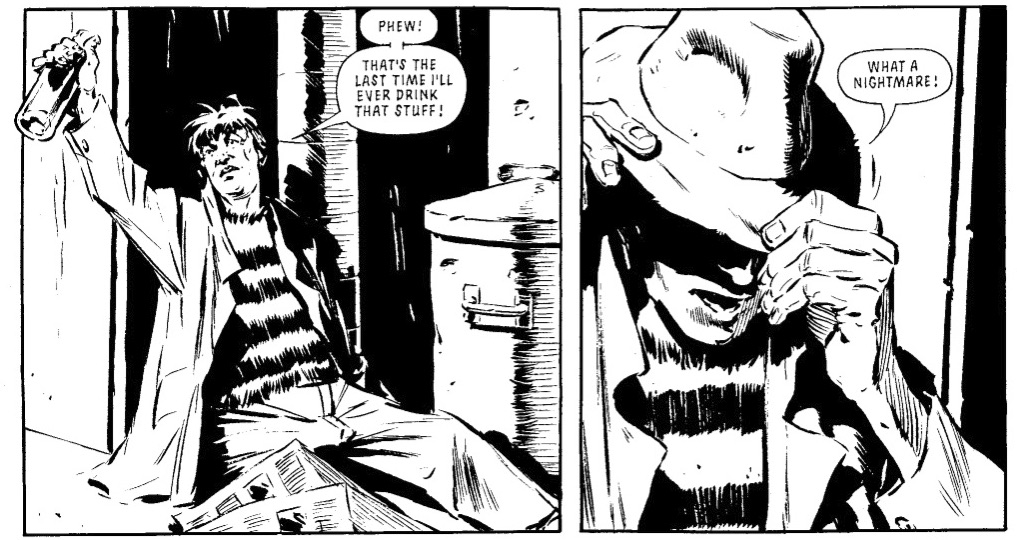
0:00:00-0:03:23: After a brief pre-credits public service for those in the U.S. with Amazon Prime — really, Future Shock is a fun film — we get things started by introducing the two books we’re covering in this episode: Judge Dredd: The Complete Case Files Vol. 13 and The Dead Man, a non-Dredd strip that’s actually about Judge Dredd after all. You’ll see.

0:03:24-0:21:06: There’s no getting around it, and we don’t even try; Case Files Vol. 13 isn’t great. Jeff has some feelings about why that is, and they revolve around the idea that, now no longer a writing duo, John Wagner and Alan Grant are both suffering from the split. We talk about the difference between their styles, and also pick apart a couple of stories in particular where Grant — by far our least favorite of the two — feels like he’s dropping the ball on what we’re expecting from the strip at this point.
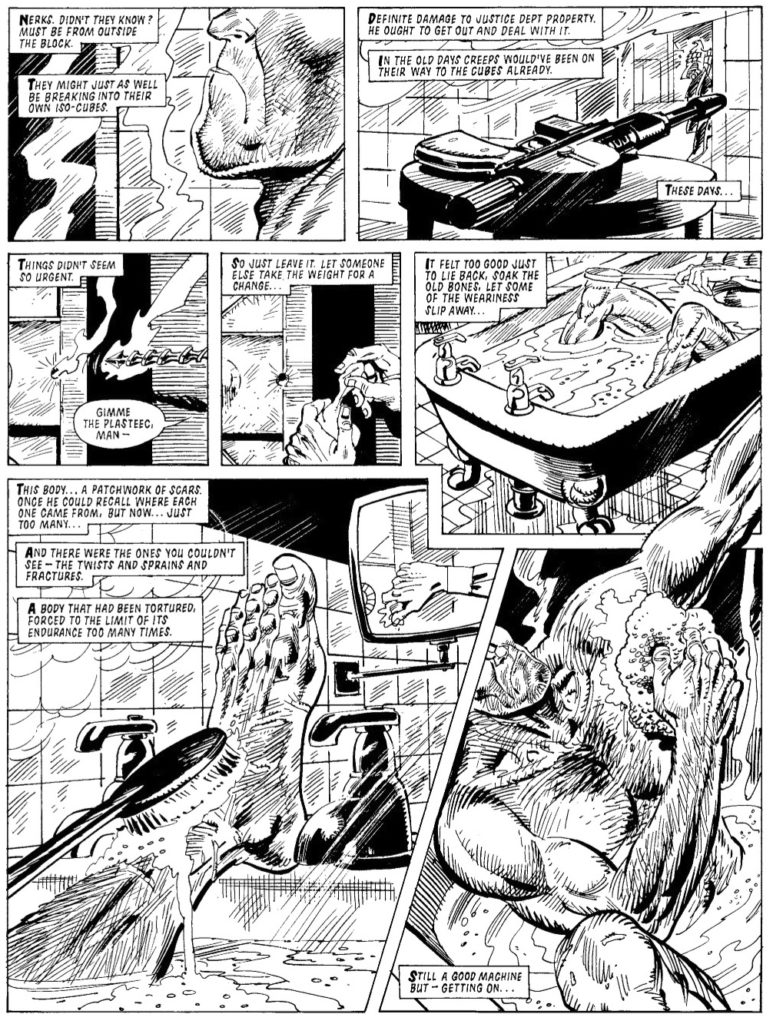
0:21:07-0:43:45: Wagner, meanwhile, has his share of misfires — we’ll get there very soon — but the strongest stories in this collection come from him, and we talk about a couple of them for a bit: “Banana City” and “In The Bath,” the latter of which might be the favorite story of both of us in this book. (For once, we didn’t actually talk about that during the episode.) We discuss Wagner’s strengths as comparative to Grant’s, before touching on some of the failures he offers up in this collection, including something to utterly devoid of a point that Jeff even came up with head canon as to why it exists. (We’re looking at you, “An Elm Street Nightmare.”)
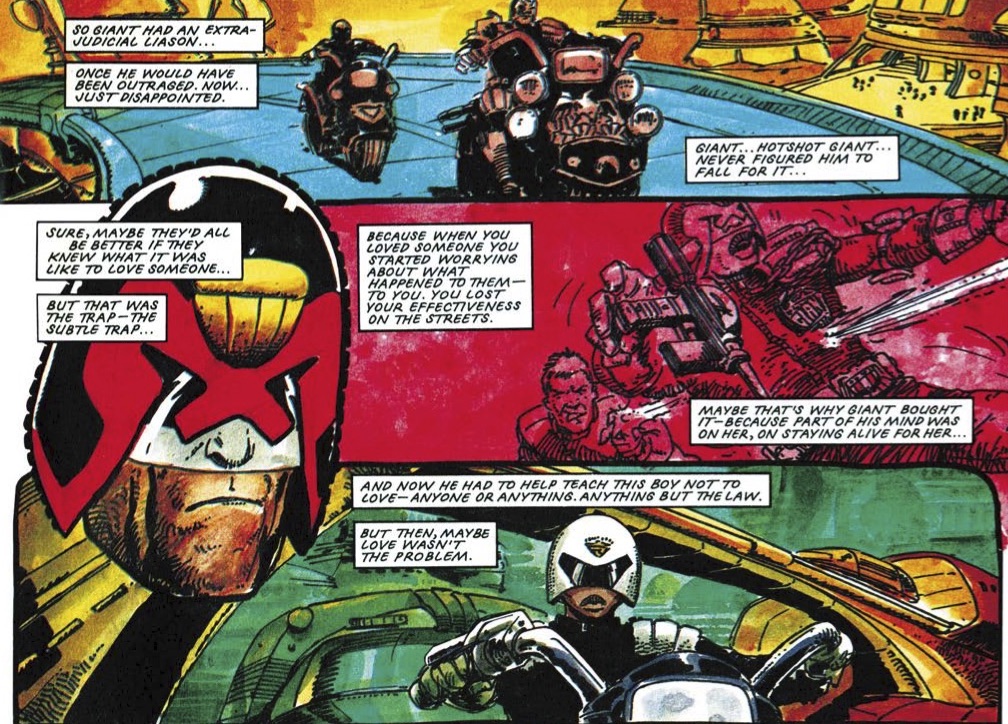
0:43:46-1:05:15: Have you ever thought there were parallels between this era of Judge Dredd and the Star Wars prequels? I hadn’t, until Jeff makes a pretty convincing case on two different occasions, relating to two different stories in this collection — which were published a decade before Episode I reached theaters. Also under discussion: My love for the Cadet Kraken storyline, whether or not John Wagner is writing about the “nature versus nurture” argument and, if so, what side of the argument he’s on, and how “Young Giant” is really all about Judge Dredd and Judge Kraken, really. Oh, and “Letter to Judge Dredd,” a one-off that makes it clear that John Wagner is out to break the strip entirely.
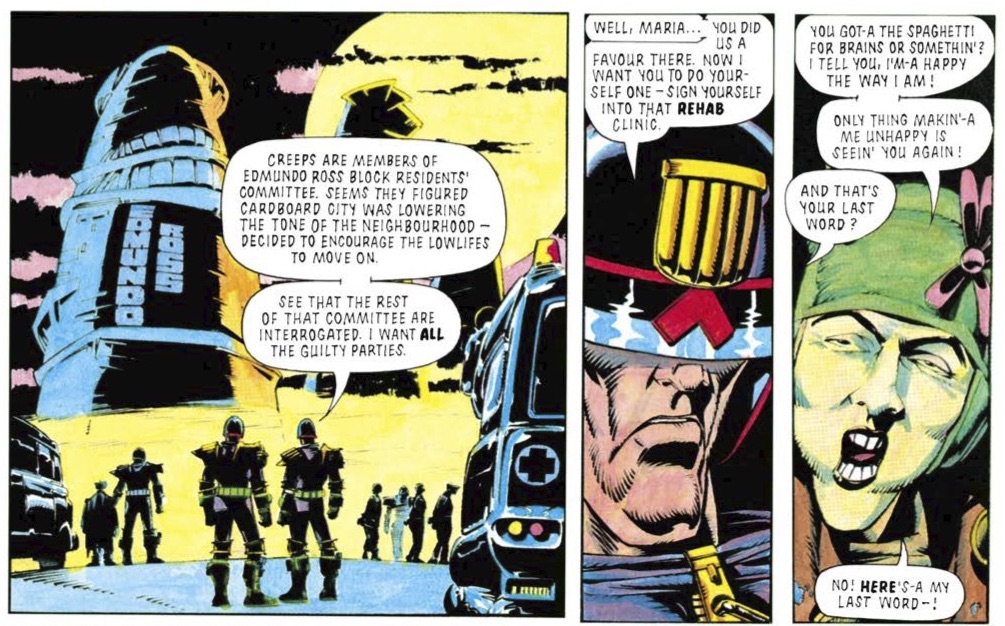
1:05:16-1:15:02: For all that we didn’t love the book, we’re still willing to accept that there’s good stuff to be found, especially in its second half — even if Jeff and I don’t see eye-to-eye on the return of Italian stereotype Maria in the three-part “Cardboard City,” which Jeff compares unfavorably to the work of Robert Kanigher. Really, that’s just mean.
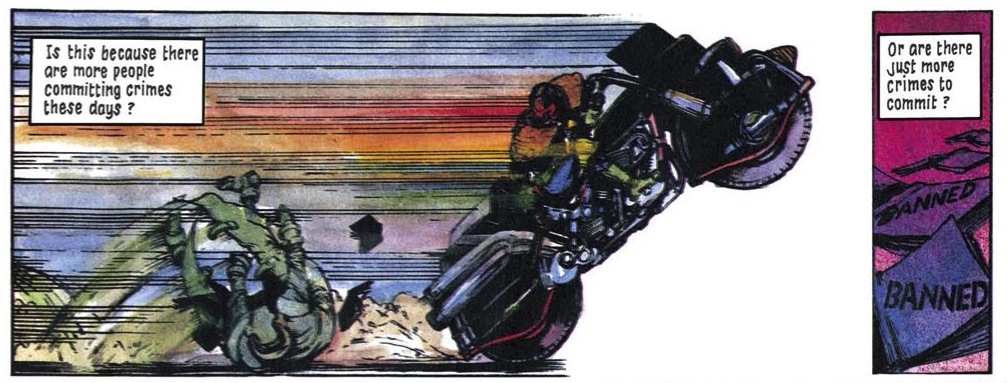
1:15:03-1:15:38: As we say goodbye to the volume, we ask whether it’s Drokk or Dross, and the answer isn’t particularly good, sadly. (It’s also not surprising, considering that we’d just talked shit about the book for an hour.)

1:15:39-1:26:20: Things improve considerably as we turn to The Dead Man, which both of us adored. It’s a Dredd strip in secret, and we talk about the ways in which it succeeds even beyond the last-minute-reveal: How much we love Wagner’s writing (under a pseudonym) and John Ridgeway’s atmospheric artwork, and the ways in which it isn’t a Dredd strip, even though it really is.
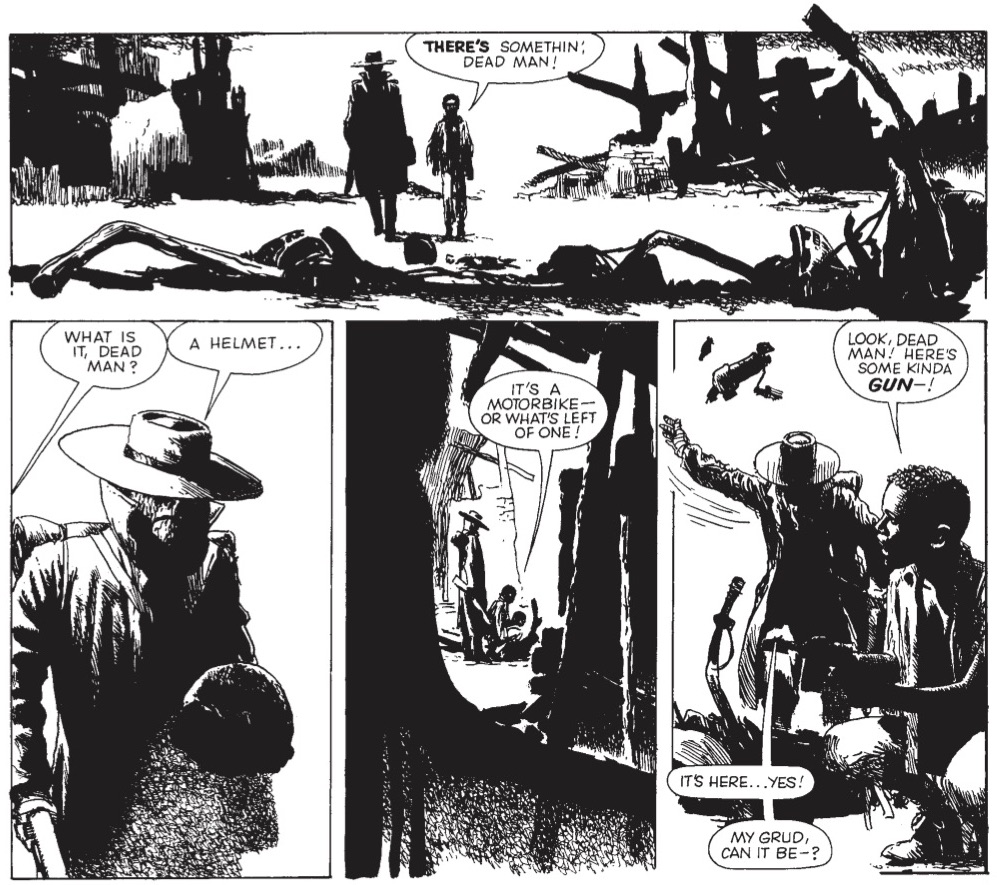
1:26:21-1:41:59: The strange thing about The Dead Man is that Wagner is telling the end of a character arc at exactly the same time as he’s telling the start of it, and we talk about what that means, as well as the ways in which this is the kind of formal trickery that can only be done in a comic like 2000 AD, for numerous reasons. Also discussed: Whether Dredd, once reborn, is an arrogant asshole and whether Yassa ends up paying the price for Dredd’s sins in a way that intentionally underscores Dredd’s responsibility.
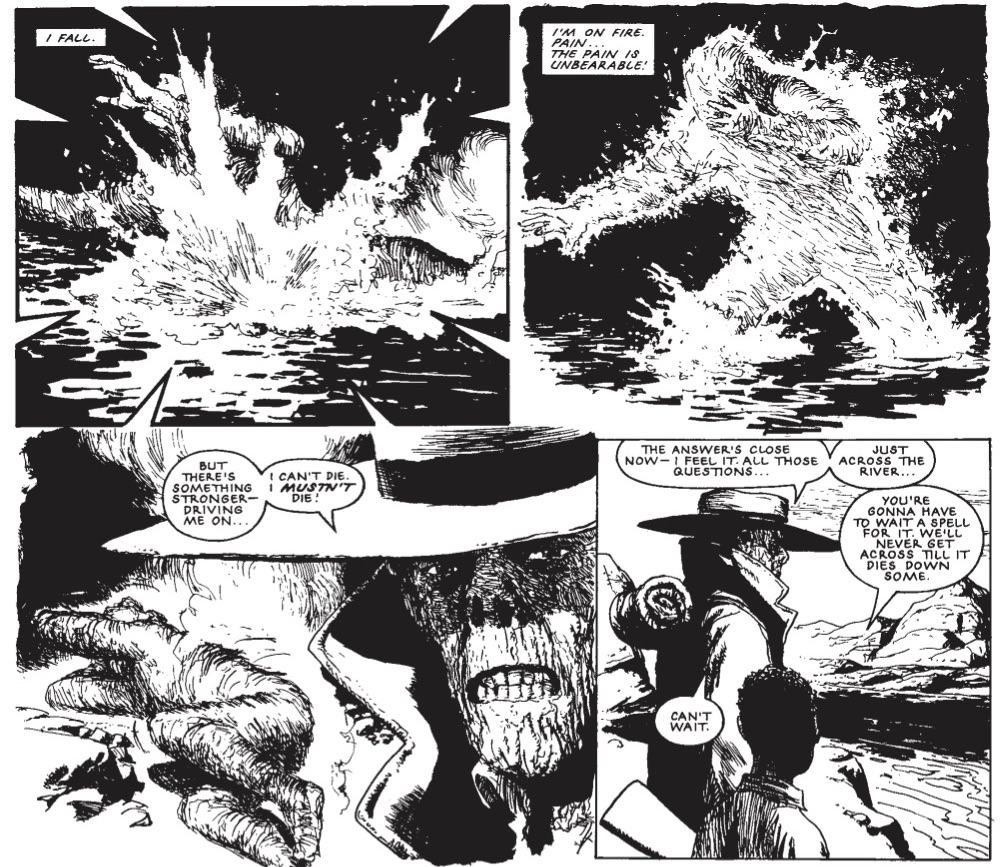
1:42:00-1:53:47: I revisit the experience of reading The Dead Man in 2000 AD as a kid, and how the surprise felt at the time — unlike Jeff, I really did go into it cold — while also sharing a spoiler for Zenith: Phase III that I… maybe should have given a spoiler warning out for, even though it came out 30 years ago…?
1:53:48-1:57:15: Drokk or Dross, once again, and it’s a lot more favorable than Case Files Vol. 13, thankfully.
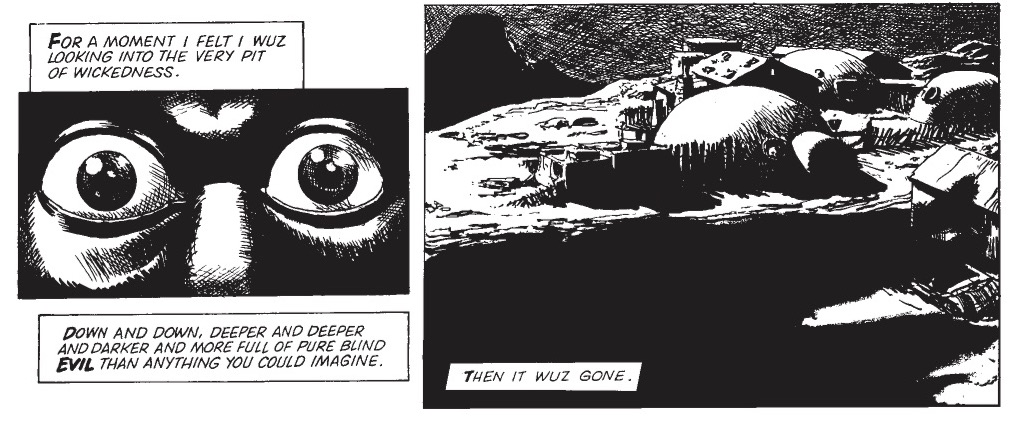
1:57:16-2:09:12: For once, Jeff actually read ahead of what we’re talking about, and we talk about just why that is, and then talk about what does lie ahead, and how it connects up the various threads that Wagner has been stringing along for a couple of Case Files volumes by this point, and also pretty much destroys Mega-City One even though we as readers today know that the strip continues for another three decades after that point. Cognitive dissonance, ahoy…!
2:09:13-end: And so we return to the end of things, as we talk about the Tumblr, Instagram and Twitter of things, not to mention the Patreon; we also touch for the briefest of seconds on how strange things are in the world right now, because — well, have you seen the news? Still, things really could be worse, which is kind of what next month’s episode is going to be all about…


For those looking for the direct link, here it is: http://theworkingdraft.com/media/Drokk/DrokkEp14.mp3
Did “And the Wind Cried” always have an empty text box in the bottom left panel of the first page, or did the text fall off at some point while reprinting it?
It’s like that in the original Prog 637 as well.
Thanks!
As Wagner was writing Dredd, and Wagner and Ridgway were doing “The Dead Man,” Wagner and Colin MacNeil were producing the Chopper epic, “Song of the Surfer” (#654-665). It’s pretty great, pretty serious, and very dark. When you read the lighter Dredd strips of CCF 13 in conjunction with TDM and SOTS, it’s kind of relief. So, with the very notable exceptions you guys mention, which move Dredd toward his next step of evolution, the throwaway Dredds might be somewhat purposeful in leavening the intense atmosphere of those other great Wagner stories.
I was going to make a similar point. Reading along with the podcast using the original Progs I also couldn’t resist reading stuff like Zenith Phase 3, Slaine: the Horned God, Judge Anderson: Triad (where she comes up against Orlok) and of course Dead Man and Chopper as mentioned above. So having thoroughly enjoyed the whole experience it was surprising to listen to this and hear the negative reaction. I guess most likely I would have felt the same reading the Dredd stories in isolation, but that wasn’t how they were originally published and with the other stories they fitted in very nicely to make a good mix overall.
Clint Eastwood’s character is attacked in the bath in High Plains Drifter (by the woman he raped earlier in the movie…). If we are specifically looking for Eastwood/Spaghetti westerns, Tuco (Eli Wallach) is attacked in the bath in The Good, the Bad and the Ugly.
Thanks, I knew I’d seen something like it before.
Damn shame about that bit of ultra-misogyny in High Plains Drifter because there’s a ton of other stuff in there I love.
I don’t see the distinction between the Judges and the Judda as being religious. The Judda are a cult of personality. The Judges already seem pretty much like warrior monks and nuns to me -devoted to a text, practicing celibacy and (presumably) often chastity, the citizens are their flock, who they protect, chastise and correct. Biblically, Judges precedes Kings, maybe the Judges replacing democracy was a back-to-basics program?
I wondered if the use of Will (Wim) Wenders as a name in Letter to a Judge was a call back to John Cassavetes is Dead. Just using the name as a callback in a story which shows what you can do when it isn’t all improv.
I was a little surprised you didn’t mention that we’re all pretty much in the iso-cubes now…
Oboy. I hadn’t made the iso-cube connection before, David. Now I’d like to stop making it, please?
It gets worse. It Pays To Be Mental plays metatextually with the idea that reference to the the iso-cubes typically the marks the conclusion to a Judge Dredd story – that the iso-cubes represent the cessation of narrative. So in drawing this connection, David has suggested that our current situation represents the end of all our stories, and that we are, narratively, ceasing to exist.
I mean, I hope that isn’t the case…
Graeme, If you are looking for content during these down times, what would you think of like a primer on other 2000AD strips in the Dredd universe? I just found out about Black Atlantic and I am fascinated with this universe and would love trusted direction
I concur! A little sketching in of some of the other highlights of 2000 AD would be great, if possible.
It’s like that in the original Prog 637 as well.
Am I correct to assume that The Dead Man isn’t in print? I tried to find one via the usual channels but they were all priced as collectibles
You can buy it directly from the 2000ad webstore (which I did last month), but I didn’t see it available in any other place.
https://shop.2000ad.com/catalogue/XB349
The greatest flaw of the print version (I think) is that it loses the double-page reveal of the Sisters of Death. You get one sister, turn the page and get the other.
I’m not inclined to be quite as easy on the racism in Banana City as our hosts, but it marks an interesting point in the strip’s use of places that are “foreign” to Mega-City One. This feels like an allegory for the actual USA’s relationship with Central American countries — a very salient topic at the time for obvious reasons. I’m always on the lookout for places where Mega-City One shifts into “future America,” but this isn’t America-as-filtered-through-British-watching-of-US media, which is what Judge Dredd started as to a significant degree. This is an attempt to use Judge Dredd to comment on *actual* America. Note that Hershey and Dredd are explicitly “Americanos,” and also calling Judge Batista that, which is hardly a subtle reference.
This is interesting to locate in terms of 1989, that astonishingly consequential year. Mega-City One is clearly meant to be a superpower to which Ciudad Baranquilla has to defer. If one thinks in terms of what has actually happened to MC-1 in recent years, this might not be all that plausible – this is a state a few years after from having half its population die in nuclear annihilation. But it’s a scabrously cynical look at the USA at the time of writing, I think, one that says, “Now that the USA doesn’t have the Cold War as an excuse to support corrupt regimes and bully smaller countries — what, you think it’s going to stop?”
On The Dead Man, a couple of additions to what our hosts said:-
– Our hosts commented on how part of how the trick worked* was the fact that this isn’t a tone that we’ve seen Dredd use. An added detail that reinforced that at the time was that John Ridgeway had previously drawn at least the first Luke Kirby story, which was tonally a bit like this, and had been an unusual departure for 2000 AD into straight magical-fantasy-horror territory without a SF ingredient. So it was easy to file this under The Same Sort Of Thing.
– Wagner had clearly consulted an atlas, because the town names locate this all as happening in real places in Louisiana. (One’s slightly wrong, “Sugarton” vs. “Sugartown,” but that may be a lettering mistake.) One wonders if Wagner saw that there was a town in Louisiana called Crowley and went, “Well, that’s just too good not to use for a horror story.”
*I’d like to say that I figured the twist out at the time, but I didn’t. I did have some idea it was coming, though, because a perceptive friend of mine worked out that the Dead Man could easily be Dredd and suggested it to our circle of 2000 AD readers.
I watched Future Shock and enjoyed it quite a bit. Was Halo Jones really that good? If so I will have to track it down.
“Good setup that he does nothing with” is sadly the course Alan Grant will follow in everything else I’ve read of him from this point in his career on. (For reference, I’ve read his Judge Anderson, Mazeworld, and most of the stuff he did with Norm Breyfogle, from Batman through their Anarky series). He suffers much more from losing Wagner as a writing partner than Wagner does from losing him. It’s almost a cheap shot to say Grant’s interest in ideas over people is what made his turn to cyber-Randianism in the 90s inevitable, so I’ll just move on. A useful comparison between the two would be their work with Arthur Ranson, Grant on Mazeworld and Wagner on Button Man. Mazeworld is a kaleidoscope of ideas that has a cypher of a main character at it’s heart, where Grant doesn’t so much show characters developing as assert it, while Button Man and it’s two sequels are a single setup with a laser focus who the main character is and what variations Wagner and Ranson can squeeze out of the setup.
Another reason for the slapdash nature of the casefiles could be that they were clearing out old ideas and scripts ahead of Necropolis. As Wagner knew he was leaving the strip soon, this volume is sort of a last call for any ideas that hadn’t been done, or things he wanted to revisit. That’s also why Maria gets brought back for a curtain call, Wagner was saying goodbye and tying elements off before burning the strip to the ground with “Letter.”